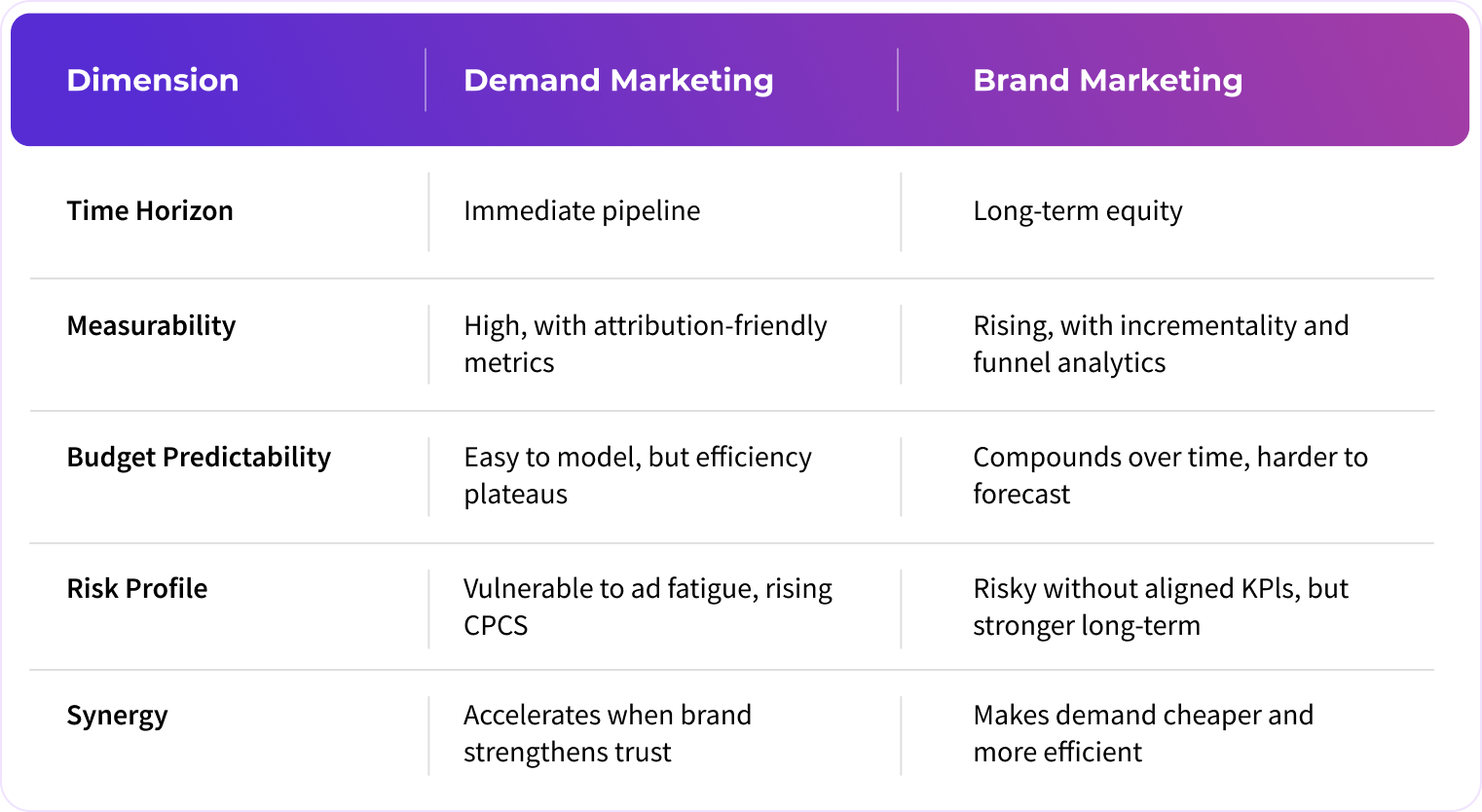

Book a Demo
Thank you! Your submission has been received!
Oops! Something went wrong while submitting the form.
In 2026, marketing leaders will be entering planning cycles under extraordinary pressure. CFOs and boards expect every dollar to be tied to measurable growth. CROs push for a predictable pipeline in an increasingly complex buying environment. Meanwhile, competition for buyer attention has never been more intense.
Against this backdrop, one of the oldest debates in marketing has re-emerged with new urgency: should companies prioritize demand generation or brand marketing? It’s a false choice, but one many leadership teams still struggle with. Demand campaigns deliver measurable pipeline quarter by quarter, but without brand equity, efficiency erodes. Brand investments build recognition and trust, but without activation, they risk being labeled “soft spend.” The leaders who succeed in 2026 won’t choose one side; they’ll master the art of dynamic balance.
The tension between demand and brand is not new, but the forces shaping it in 2026 are. Four dynamics stand out:
These forces explain why the brand vs. demand debate feels sharper in 2026. Pressure for accountability pulls dollars into demand. Market realities push them back into the brand. The smartest leaders navigate both.
Demand marketing has become the default investment priority in recent years. Paid search, retargeting, outbound, and performance campaigns provide attribution-friendly proof points, including leads generated, pipeline created, and deals closed.
But demand-only strategies hit ceilings fast. Costs rise, audiences tune out, and conversion rates decline. A pipeline built on demand spending without brand support may appear impressive in the short term, but it gradually loses efficiency over time. The risks of leaning too far into demand include:
Demand fills today’s funnel, but it cannot build tomorrow’s resilience.
Brand has shifted from being a discretionary line item to being a growth imperative. In 2026, it acts as the efficiency multiplier for demand. Recognition means buyers are more likely to open, respond, and progress. Trust reduces negotiation friction in multi-stakeholder deals. Preference strengthens win rates and protects pricing power. In markets where competitors fight for the same keywords and inboxes, brand equity tilts the field.
What makes brand especially powerful in 2026 is that its impact is finally measurable. Channels historically tied to brand building, including content, thought leadership, and email, are showing strong ROI. More importantly, advances in attribution and cohort-based incrementality testing prove how brand touches accelerate conversion, shorten cycles, and improve lifetime value.
Cutting brand to over-fund demand might provide a short-term bump, but it strips away the very foundation that makes demand efficient.
The 60/40 brand-to-demand ratio popularized by IPA has served as a benchmark for years. But in 2026, leaders are moving beyond static rules. Balance is no longer about fixed percentages; it’s about dynamic calibration.
The lesson is simple: static budget splits are liabilities. Agility, guided by data, is now the competitive advantage.
Perhaps the most profound change reshaping the brand vs. demand debate in 2026 is the ability to measure both with equal credibility. For years, demand had the advantage of easy attribution. Brand was dismissed as vague. That imbalance is gone.
Modern platforms unify GTM data into a single funnel view, crediting both brand and demand for their influence on pipeline creation and bookings. AI-driven attribution prevents last-touch bias, while incrementality testing proves the lift from brand campaigns.
This shift changes more than marketing dashboards; it transforms boardroom dynamics. Brand can now be defended as a provable asset, not an act of faith. Demand can be optimized for efficiency, not just activity. Together, they form a measurable system of growth.
Every budget decision carries trade-offs. The question for 2026 is not which side wins, but how to maximize the synergies.

The danger lies in extremes. Over-index on demand, and efficiency decays. Over-index on brand, and near-term pipeline dries up. The winners are those who maintain dynamic balance, fueled by data rather than dogma.
One of the most overlooked aspects of this debate is that it extends beyond marketing. In 2026, the balance of demand and brand has become a cross-functional issue.
When these leaders align on a shared measurement framework, budget debates shift from “brand vs. demand” to “how does the mix accelerate growth?”
Balancing brand and demand is no longer a static budget exercise. It’s an ongoing discipline. The smartest leaders are doing three things differently this year:
The stakes are high. Overreliance on demand leads to escalating acquisition costs and fragile efficiency. Overreliance on brand risks softens near-term performance. In volatile markets, resilience requires both. The companies thriving in 2026 are those that:
This isn’t just a marketing philosophy. It’s a strategic discipline that protects growth in competitive, resource-constrained environments.
The demand vs. brand debate is outdated. The question for 2026 is not which side to favor, but how to integrate, measure, and balance both in real time. Demand delivers today’s numbers. Brand ensures tomorrow’s efficiency. Together, they create the compounding effect every board is asking for: predictable, provable, and sustainable growth.
The leaders who embrace this balance, with the discipline to measure rigorously, calibrate dynamically, and align cross-functionally, will define the next era of B2B growth. Those who cling to old binaries will find themselves overspending, underperforming, and outpaced.
In 2026, the competitive edge isn’t in choosing demand or brand. It’s in proving the impact of both and orchestrating them intelligently for lasting growth.

